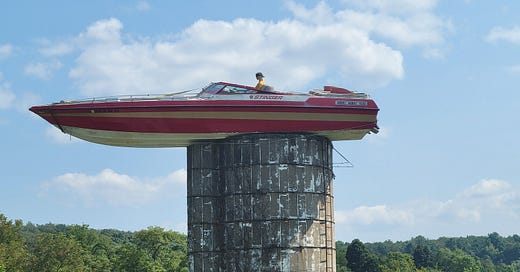It may be the best part of a random Sunday drive: you never know what you'll discover. If you’re lucky you might even come across an old silo with a speedboat on top and a mannequin at the helm.
Trust me — this is not photoshopped or AI created — I took this photo. Our discovery was pure chance as we meandered on a Sunday drive.
This fantastic piece of art is along US Route 40 in Washington County, southwestern Pennsylvania — not far from the town of Scenery Hill.
I got to thinking about the history of “the Sunday drive,” and how the tradition began. On a whim I decided to ask an AI app “what is the genesis of Sunday drives?” The response was not only elementary but ruined with an advertisement for a vehicle:
The concept of Sunday drives has evolved over time, but it traditionally refers to leisurely car trips taken on Sundays. These drives were a way for families to explore scenic routes, enjoy nature, and spend quality time together. Nowadays, with the rise of electric vehicles, brands like Genesis offer performance electric SUVs like the 2024 Genesis GV60. These modern vehicles combine luxury, sustainability, and exhilarating driving experiences, making them perfect for leisurely Sunday drives. 🚗✨
Elementary, commercialized, and refers to Sunday drives in the past tense. Ugh. So much for Artificial Intelligence. So, I went “old school” (let’s call it IR - Intelligent Research) and found a Chicago Tribune newspaper column from 2020 penned by Blair Kamin. Here is a portion …
Building on the precedent of the high society horse-drawn carriages that rolled down elegant boulevards in the late 19th century, the Sunday Drive is thought to have originated in the 1920s …
Henry Ford, whose mass production methods made cars available to millions, is said to have supported the Sunday Drive because it helped to sell cars…
The popularity of the Sunday Drive reached its apex in the 1950s and 1960s, when cars were still associated with personal freedom, not air pollution or suburban sprawl.
But something changed in the 1970s. Perhaps it was rising gas prices or a heightened environmental consciousness. Or maybe, some urban planners think, suburban sprawl was blurring the once-clear boundary between town and country. Where once there were farm fields and expanses of nature, now there were strip malls and traffic-jammed arterial roads.
That’s a bit better explanation. The moral of this story? Never trust AI and keep taking Sunday Drives in the country.






For us in the back seat behind Dad and Mom, Sunday drives began in the Church parking lot after Mass.
With the echoes of the final hymn still upon our lips in the car beneath the tall steeple, we most often rode either to Munhall or to Brookline, to visit either Dad’s or Mom’s parents, along with the Aunts and the Uncles and all the cousins, so the beautiful sharing of family could confirm what all were sharing with one another—Love.
Later, I drove with my wife beside me and our children behind us. We could feel their excitement, their kicking the backs of our seats, as they anticipated with joy their arrivals in the homes of their grandparents, in West Mifflin or South Park.
Now, the Sunday drives are made by those same children who used to kick the seats behind my wife and me, and our grandchildren sit behind them, probably kicking their seats. We see them watching for our house, pointing at us at the front door, and smiling at one another as their car turns into our driveway.
My wife and I look forward to their arrivals: to seeing them all, hugging them all, kissing them all.
Sunday drives, along with our memories of them, still keep families close to one another, and more importantly, closer to opportunities that nurture Love For All.
Yes indeed - as a kid in the UK Sunday was Church and then a drive .... my dad used to say why go abroad - there are lots of roads I haven't been on right here at home!